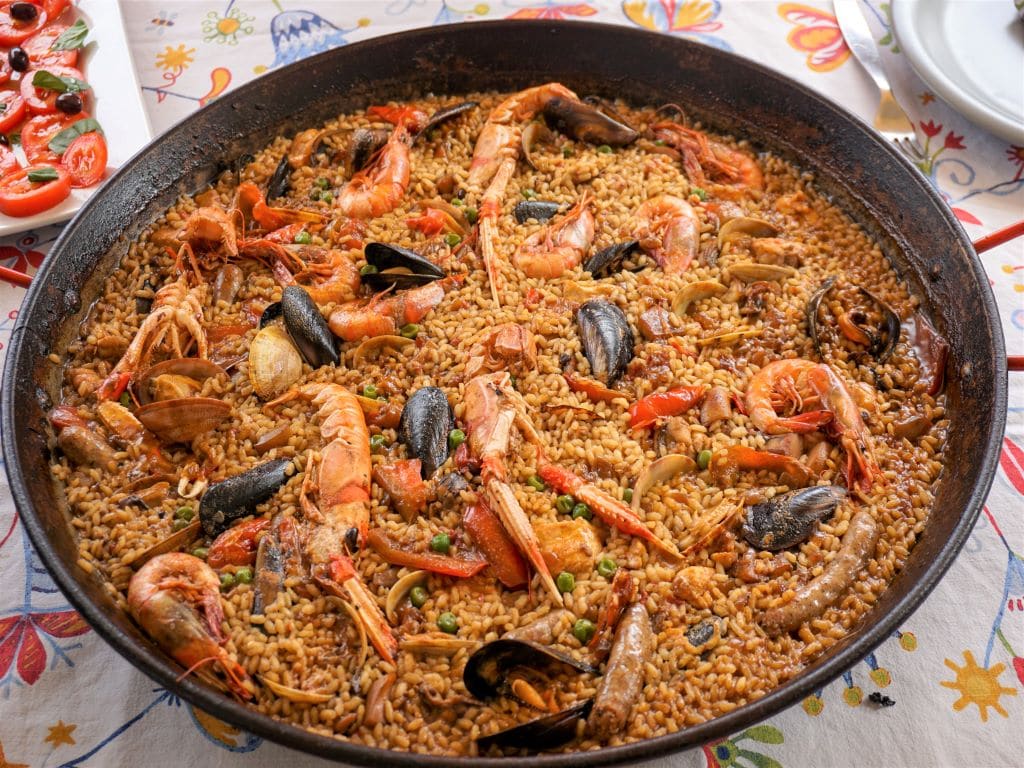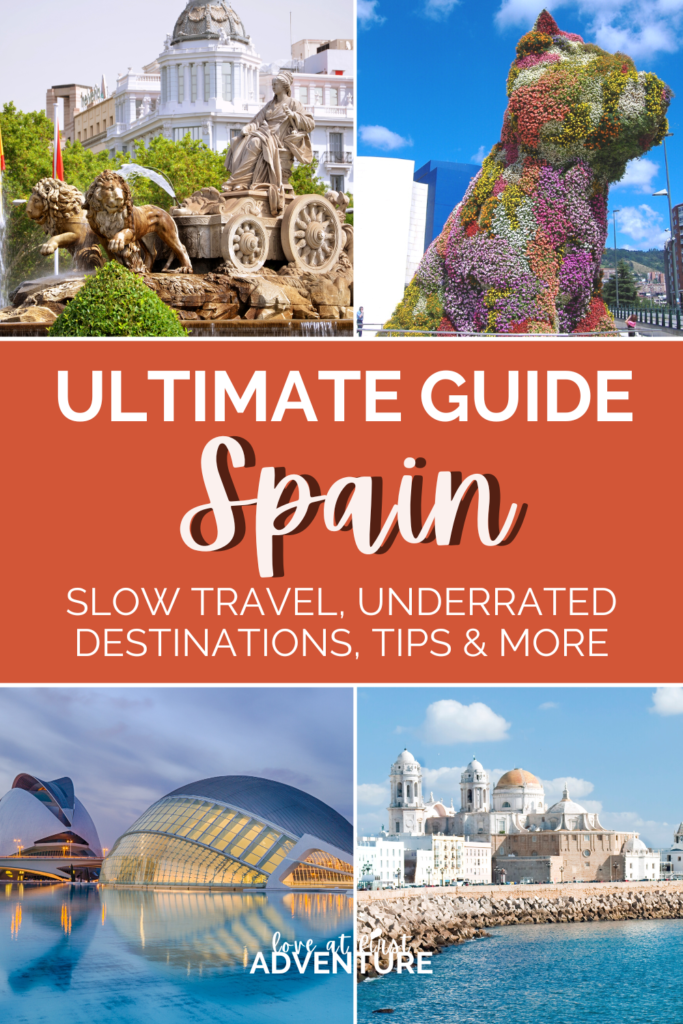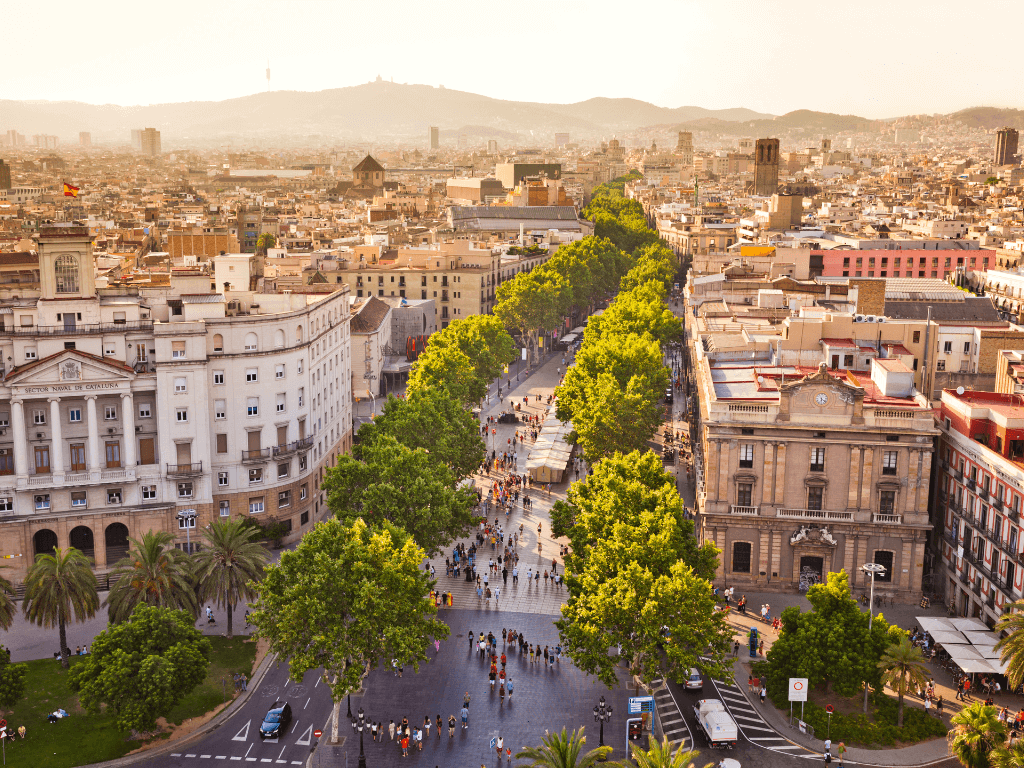Ultimate Spain Travel Guide
Disclosure: Some of the links provided on this website are affiliate links from which I may make a commission if you make a purchase.
Welcome to our Ultimate Spain Travel Guide!
It’s easy to immersive yourself in Spain, if you ask me. Having lived in Spain and traveled all around the country over the past two decades, I love this laid-back county.
While many people think of Madrid and Barcelona when planning a trip, Spain has so much more to offer. Off-the-beaten path towns, stunning scenery, café culture, wine and tapas, and colorful traditions, to name just a few.
Certainly, both the newbie and well-seasoned traveler will find something exciting to explore, learn, or eat (!) in Spain.
If you desire a deeper, immersive travel experience in Spain, keep reading. In this article, we’ll give you an overview of what to expect when visiting Spain, what to do, when to go, and more.
What Can I Expect from Spain?
A Slower Pace: Known for a slower rhythm, an adjustment to Spain’s timetable is often difficult for foreigners. It’s also one of the most enjoyable aspects of vacationing in the country. Just ask any slow traveler or British expat.
Currency: The Euro (€) is the official currency of Spain
Electrical Plug: Spain uses type C and the type F electrical plugs. These have two round posts side-by-side. Spain operates on 230V and 50 Hz. Get a plug adaptor to use your appliances in Spain.
Visa: As a part of the Schengen area, Americans can enter Spain for a total of 90 days on a tourist visa. You do not need to apply for a visa ahead of time; simply let Customs know you are in Europe to travel upon arrival. (This will change mid-2024.)
Religion: Spain has a fascinating religious history. Open your eyes, and you’ll find evidence of Christianity, Islam, and Judaism Spain’s architecture, food, and culture. Today, most Spanish identify as Catholic or non-religious.
Languages: The main language spoken in Spain is Spanish, but there are five languages spoken in total: Spanish, Galician, Basque, Catalan, and Occitan as well as regional variants. Don’t worry, you’ll get along just fine speaking Spanish (castellano), but it’s always appreciated to learn a few words of the local language.
Opening Hours: Many local businesses open around 10 am, close during the siesta from 2-6 pm, and re-open in the evening for a few hours. In the larger cities and more tourist-centered areas, many stores stay open. Most businesses (including grocery stores) are closed on Sundays. Check schedules ahead of time.
Regions: Regional identity is strong in Spain. Across Spain’s 17 regions, you can expect to find many distinctive local flavors, traditions, and architecture. Stop by any time of year for unique regional parties, unlike anything you’ve seen before.
Festivals/Celebrations: Spain is well-known for a variety both well- and lesser-known traditional fiestas or festivals and celebrations throughout the year. Some of our favorites are Las Fallas (Valencia, spring), New Years Eve, and Semana Santa (Holy Week/Easter). Be sure to check your destination so you don’t miss out on the festivities.
Where to Go in Spain
There is no shortage of amazing locations in Spain. Here are some must-see places to add to your itinerary:
1. Madrid
Madrid will easily win the slow traveler’s heart with it’s old world architecture, art scene, nightlife, and plentiful museums. There is so much to see and do in Madrid, but shopping along the Gran Via and it’s connecting streets is electric.
2. Granada
Visit the Alhambra in Granada for a glance at the splendor of Moorish Spain. Afterward, shop in Granada’s wandering streets, sample North African fare, and take a dip in the Arab baths.
3. Málaga
This city holds a special place in my heart as the first city visited in Spain. A lively yet calm Mediterranean city on the Costa de Sol, Málaga has a little bit for everyone—great beaches, shopping, museums, history, and a skyline view that includes the bull ring.
4. Bilbao
Bilbao (and the northern Basque region) is a city all of it’s own. The architecture of Bilbao is well thought out, every detail not only functional but artful. While your eyes take in the architecture, don’t forget to test Basque pintxos or pinchos, one-bite delicacies available for choosing on any bar counter before tuning in at a hip hostel.
5. Barcelona
The most colorful city.
Top 5 Things to Do in Spain
1. Eat tapas and raciones late into the night
Well known for partying, it seems the Spanish do not sleep. Share a variety of small plates and divine wines with friends, new and old in any local bar or cafeteria.
2. Enjoy sevillanas in the south
Get to know the gypsy roots of flamenco in Andalusia.
3. Hike the Camino de Santiago
Hike one of the many pilgrimage routes along the St. James Way to Santiago de Compostela. If that sounds interesting, read our post on how to know if the Camino is calling you.
4. Savor world-class wines
Wine lovers are sure to fall in love with one of Spain’s many world class regional wines (El Bierzo region is our favorite!). Not only do they taste heavenly, but wine is incredibly cheap, making treating your friends to a glass easy on any budget.
5. Take in Masterpieces at World-renown Museums
You don’t have to be an art enthusiasts to marvel at the art created by famous Spanish artists (Goya, Picasso, and Velazquez to name just a few) in Madrid’s three major museums as well as throughout Spain.
Typical Costs When Traveling
Accommodation – Although costs have risen in recent years, accommodation is Spain is still affordable for budget, mid-range and luxury travelers alike. Clean, funky hostels and hotels are readily available for travelers.
Barcelona can be a bit pricier, especially in the high season. But, in the capital of Madrid, lovely private rooms can still be found for 50 euros/night. In many of the smaller and mid-size cities, you’ll find a range of accommodation options. Bilbao, for instance, has everything from luxury hotels to fun Airbnbs to cool and affordable hostels.
Vacation rentals are available in general, but some cities have begun to crack down as they are driving up prices for residents.
Food – Sit down for a light Spanish breakfast around 10 m, costing about 3€. Lunch is enjoyed later in the day around 2 pm. As the main meal of the day, fill up on the three-course meal called the Menú del día, wine included (10-12€). Dinner time in Spain starts around 10 pm and consists of light, shared fare, and drinks.
Transportation – The transportation system in Spain is very sophisticated and affordable, and you can easily get around larger cities using public transportation. For travel in-country, Renfe operates a system of trains ranging from commuter to high-speed long-distance trains. ALSA is the go-to bus line. Trips are easily searched and booked online, but please note fares are not typically available more than 2 months in advance.
Activities – There is no shortage of activities in Spain ranging from festivals, museums, beaches, parks, eating tapas, or walking the Camino de Santiago. Entry fees are minimal.
Suggested daily budget – 40-50 EUR / 44-54 USD (Note: This is a suggested budget assuming you’re staying in a hostel, eating out at local establishments, and using local transportation. Using the budget tips below, you can always lower this number. However, if you stay in luxury accommodation or splurge on meals, expect this to be higher!)
Money Saving Tips
- Skip the sit down restaurants – We’ve already mentioned that the Menú del día is a great way enjoy typical Spanish cuisine at a fair price. But, there are rumors that the tradition may be on it’s way out. Other affordable food options are fast casual dining in Spain, grocery stores, and stands or bars offering light snacks (try the tuna empanadas.
- Rent a Bike – Like many other tourist destinations, bikes and scooters are easily found and rented for a few hours of your trip. If you speak Spanish, you can especially enjoy the sweet bicycle puns in various cities’ rental program titles (ie: Sevici in Sevilla).
- Book ahead in the high season – Budget accommodations in highly trafficked cities have a way of selling out in the high season. If you are sure of your travel dates, consider booking several months in advance to ensure a place in the center of the city within your budget.” Book your hotel in Spain.
- Sharing Economy Services – Download the BlaBlaCar ridesharing APP to see if someone is driving to your destination, and split the cost of gas. For accommodations, rent an Airbnb, Couchsurf, or participate in a work exchange. (Of course, use good judgement if deciding to use any of these services.)
Where to Stay in Spain
In each city you frequent, it’s essential to stay in the city center. Try to book within walking distance (15 minutes) to all of the major tourist attractions. In smaller cities where you can walk the entire length of the town in 20 minutes, any clean, appealing location will be suitable.
Please note that Spaniards are known for socializing late into the night. If you want a good night’s sleep, choose an accommodation that’s a few streets away from the action.
- Where to Stay + Hotels in Santiago de Compostela, Spain
- Best Hostels in Santiago de Compostela, Spain
- Best Hostels in Bilbao, Spain
Traveler Tip: Spain’s accommodations are relatively affordable outside of major cities and holiday weekends.
What to Eat in Spain

The mealtime culture in Spain is an adjustment for tourists to the Iberian peninsula.
Upon waking, feel free to have a small snack in your room or at an open bar. After a but of sightseeing, sit down for a Spanish breakfast around 10 am. This light meal typically consists of toast or pastry, coffee, and fresh juice.
Lunch is enjoyed later in the day around 2 pm as many shops close for the siesta. As the main meal of the day, tourists can fill up on the three course prix fixe meal called the Menú del día, wine included.
Dinner time in Spain starts much later, with many Spaniards heading out to eat no earlier than 10 pm. However, kitchens typically open around 8 pm. Get a table early, and plan to stay for the night. However don’t plan to eat your own entrée. Instead, sharing a range of delectable small plates called tapas and wine or beer. In the north, hop from place to place, enjoying each restaurant or bar’s signature one-bite pincho.
Best Food to Try in Spain
Paella – Although quite popular outside of Spain, you’ll never eat it again abroad once you head to Valencia and taste the original, traditional paella valenciana.
Salmorejo – A thicker alternative to gaspacho, salmorejo is eaten in Andalucía and resembles a dip. Savor this tangy tomatoes and garlic dish with small picos, small, dried bread bites.
Dulce de membrillo con queso – Finish your evening in Galicia with a simple dish of regional cow’s milk cheese with quince paste.
How to Get Around Spain
Getting around Spain is easy thanks to an excellent rail and road system.
When to Go to Spain
Spain’s Mediterranean climate is generally mild, but there is variations between Spain’s north, center, and coastline. Spring (April-May) and early fall (September – October) are the best in terms of climate and will see less tourism.
While early June is quite nice, late June-August is hot and people flock from all over the world to enjoy the sun. Beaches fill to an almost uncomfortable capacity, and the sun becomes bright and hot. However, visiting Spain in the summer is still enjoyable; take advantage of the siesta to get a respite from the heat before spending the evening eating outdoors.
See our guides to learn more about when to visit Spain:
Holidays & Festivals in Spain
Spain boasts a multitude of traditional, regional, and religious festivals and celebrations throughout the year.
How to Stay Safe in Spain
Spain is relatively safe for travelers, and incidences of violent crime are low. There is a chance for petty theft, such as of a passport or wallet, particularly in crowded tourist areas. Stay alert, keep an eye on your belongings at all times, and watch for travel scams.
There is some civil unrest which leads to protests in major cities. Steer clear of protests or large gatherings in main tourist squares or near government buildings.
Spain has an APP for their police force, the Guardia Civil. Download the AlertCops APP for Apple or at the Google Play Store. Don’t forget to register before your trip on the off change you need to alert them. Watch a short video explanation of the APP (Spanish with English subtitles).
Don’t forget to purchase travel insurance with prior to your trip in case of an emergency or trip interruption. Check out the many benefits of travel insurance.
What to Pack for Spain
The landscape and climate can change drastically in Spain, so pack a variety of clothing and footwear if you’re planning to travel extensively. While the south is known for it’s sunny beaches, the northern coast can be cool and wet.
Check out my packing list for Europe. In addition, be sure to include the following for Spain specifically:
- a sun hat (summer) – women’s sun hat | men’s/unisex sun hat
- lightweight summer dress (women) or dri-fit button down top (men) for evenings out (summer)
- bathing suit (summer)
Guidebooks & Language Learning Tools
Check out our recommended Spain guidebooks, apps, and language learning tools to help you learn about the Spanish language and culture.

Best Spain Booking Tools
What are the best sites to book flights to and within Spain?
- Skyscanner – Find the best flights that other search engines miss!
Where should I book accommodations in Spain?
- Booking.com – Access a clear and easy hotel booking process that includes hotels, hostels, B&Bs, guesthouses, apartment rentals, villas, and more.
- Hostelworld – Budget, independent, and youth travelers, search the largest inventory of hostels to choose from worldwide.
- Vrbo – Rent a room or entire home to live like a local.
What’s the best way to get around Spain?
- Omio – This ticket aggregator searches multiple providers to give you the best train and bus travel options in Europe. (Read my Omio Review!)
- Discover Cars – Best for renting a car in Europe — and globally!
- Bla Bla Car – Find a carpool ride with this ridesharing APP. Just chip in for gas!
Should I buy Spain travel insurance?
Yes! Protect your investment from trip interruptions to unexpected injuries!
- Travel Insurance Master – Best travel insurance search tool.
- SafetyWing – Good for traveling 1+ months.
- World Nomads – For active and adventure travel.
What should I pack for Spain?
Head to the Ultimate Europe Packing List for Women to get all the info you need on packing for Europe.
Go to our resources page for more booking tools we use to plan our trips.
More Spain Articles
Pin it!












